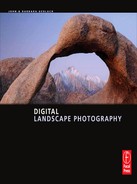1
Landscapes are Everywhere
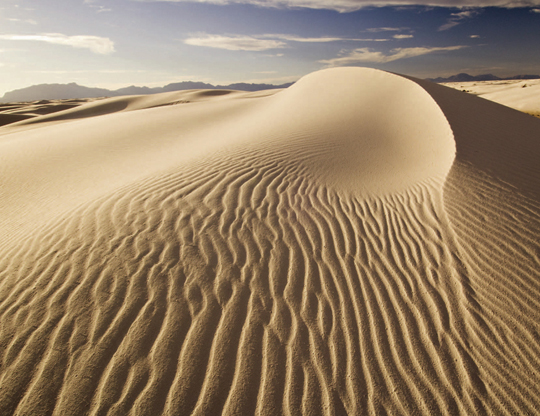
John and I love photographing landscapes and we’re thrilled to share our strategies with you in this book. We live in the mountains bordering Yellowstone National Park, so fabulous natural landscapes are all around us. At first, we considered landscapes to be geysers, waterfalls, rugged mountain peaks, seashores, sand dunes, and other natural features. But landscapes are really more than that. We don’t photograph a lot of man-made landscapes, but they are certainly legitimate subjects. Old buildings, barns, bridges, farms, lighthouses, and a massive field of sunflowers are all landscape subjects. We tend to avoid big cities which, in our opinion, are any towns with more than one restaurant, but city images are surely and often opportune, urban landscapes.
Landscapes include such an enormous variety of subjects that everyone can enjoy photographing them. They are everywhere. Regrettably, however, this book isn’t big enough to cover every possible landscape situation, so we’ll narrow the focus down to the landscapes we know best — natural scenes and old buildings. Fortunately, the techniques and strategies we highlight in this book cover most landscape possibilities quite well.
FINDING NATURAL LANDSCAPES
Landscape photographers enjoy a huge advantage compared to action, sports, and wildlife photographers because most of the finest natural landscapes were preserved years ago by law. They still exist in a fairly pristine state and they’re public property. The national parks and national monuments of the United States, and those of some other countries, probably have the best known and best preserved landscapes. These parks encompass a fabulous collection of opportunities, from the geysers of Yellowstone and the sand dunes of Death Valley to the waterfalls in Great Smoky Mountains National Park. We have been privileged to visit most of them over the years, and they’re wonderful. You could easily spend the rest of your life making exquisite landscape images without ever leaving the national park system.
The undulating sand dunes of Death Valley test your compositional skills to make sense out of endless patterns of form and light.
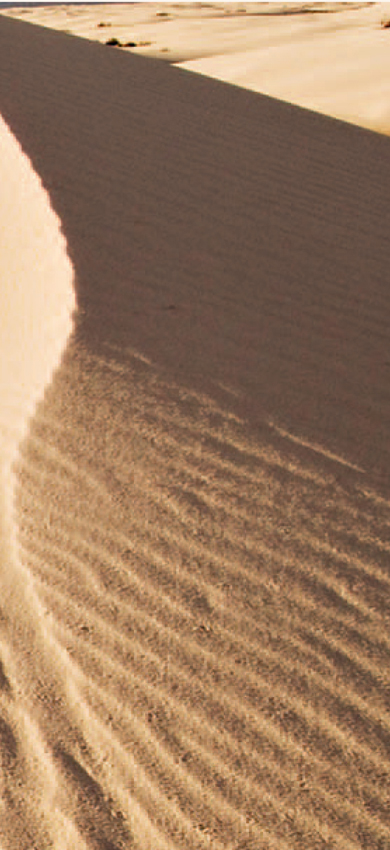
Old buildings like these found in the well-preserved ghost town of Bodie in eastern California always make us wonder who lived there and what did they think and do.
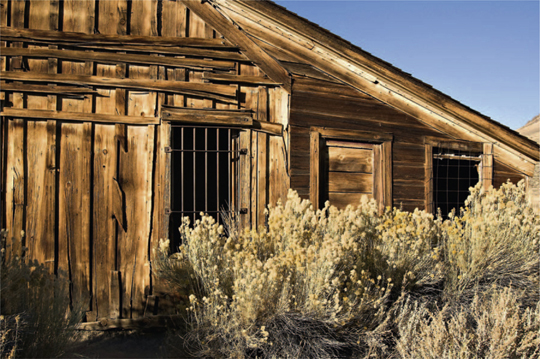
However, don’t overlook the opportunities on other public lands that are less well known. City and state parks preserve smaller landscapes, which may be superb for photography. Tahquamenon Falls, flowing the second highest volume of water of any falls east of the Mississippi River, lies in a northern Michigan state park. It’s easy to access and photograph. And a city park might offer a small pond reflecting a riot of color when the surrounding maple trees become brilliantly colored in the autumn.
Vast amounts of public land are available to photograph in the state and national forest systems. These lands are filled with photogenic streams, ponds, fields of wildflowers, and waterfalls. Especially in the western states, the Bureau of Land Management (BLM) oversees millions of acres of wild land. Fortunately, public land is well mapped, so it’s easy to find the special places that make enchanting landscape images. In the eastern states, where public land isn’t as plentiful, some land may be set aside as state game areas for hunting purposes. These lands also offer many gorgeous scenes to photograph, and it can be done quite safely if you wear hunter orange and take other appropriate precautions. If the ongoing hunting activity makes you nervous, you can avoid those lands during the short hunting seasons, and still have the state game areas largely to yourself throughout most of the year.
Another huge amount of public land is set aside in the National Wildlife Refuge (NWR) system. These lands were purchased primarily with the money that hunters paid for duck stamps or with special taxes on guns and ammunition that were earmarked for conservation. The NWR system protects wildlife-rich areas, especially the wetlands so critical to migratory birds such as ducks and geese. These lands are widely used by wildlife photographers because of the many small bodies of water that attract wildlife. Reflections in these ponds and lakes can be quite beneficial to landscape photographers, too. Call ahead to learn if the refuge will be open when you plan to visit. Some refuges have seasonal restrictions during hunting seasons and many areas may be closed during the nesting season to prevent disturbing wildlife at that critical time. One of the more scenic refuges is Montana’s Red Rock Lakes National Wildlife Refuge, which is only 25 miles from our home. On calm mornings and evenings during the summer, the Centennial Mountain Range is beautifully reflected in the small lakes that make up the refuge.
Yellowstone’s Great Fountain geyser is a sight to behold when it erupts at sunset. It’s a predictable geyser (sort of) as it erupts about every 12 hours plus or minus 2 hours. It’s well worth the wait, though.
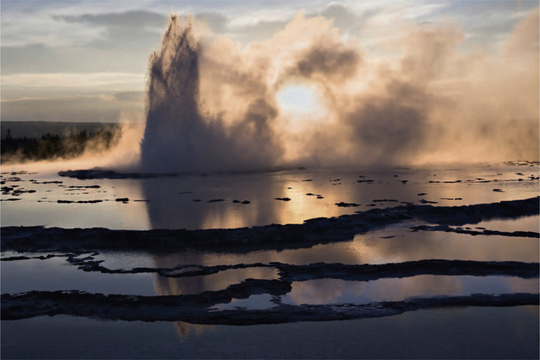
PRIVATE LAND
Private land also offers plenty of possibilities for nice landscape images. Always get permission before entering. Entering without permission is trespassing, and may have both civil and criminal consequences. It’s often tough to get permission to hunt with a gun on private land, but gaining access to photograph on private ground is usually quite easy. Landowners are often thrilled that you find their special place to have worthwhile photo subjects, and may even help you find what you’re looking for. Giving landowners a few prints of images made on their land is a nice gesture, and keeps the welcome mat out for you.
Nature centers are often built where special landscapes are found. Normally, you can get access to their land, especially if you become a member, by simply asking, and sharing your images.
SEASONAL CONSIDERATIONS
It’s always pleasant and convenient if you can find some wonderful landscapes near your home. Near home, you can easily photograph them at dawn when the scene is drenched in dew, when kissed by a hard frost, or perhaps blanketed by snow or fog, or whenever you have only a short time available for shooting. As everyone knows, many landscapes photograph best at dawn and dusk, so easy and quick access is highly desirable.
The time of the day isn’t the only variable, however. The photo opportunities of a marsh, small pond, or waterfall are quite different throughout the year. Imagine a waterfall surrounded by peak autumn color, blanketed with a fresh layer of snow, swollen by spring rains, or fringed with summer wildflowers. Many landscapes change dramatically with the seasons, and provide exciting new photo opportunities.
ELEVATION ADVANTAGES
We live in the mountains, so we understand their photographic advantages well. Spring begins at the lower elevations first and gradually climbs up the slopes to the alpine zone on top. The progression could take several weeks to several months, depending on the latitude and especially on how high the mountain peaks tower above the low valleys. When we lived in California, we saw that spring started in the foothills around Fresno in February, but didn’t reach the tops of the Sierras until July. Of course, mountains stretch out all of the seasons, so you have more time to capture the unique images each season offers. Mountains offer another crucial advantage for landscape and nature photography in general. The elevation changes make it possible to drive up and down the mountainsides, changing ecological zones as you go. For instance, in California, driving from the foothills around Fresno to Tuolumne Meadows in Yosemite National Park is just like driving thousands of miles north in terms of seeing plants and animals that are indigenous to the individual zones. The unique subjects of the different zones offer a photographer’s potpourri of landscape opportunities.
Grotto Falls in the Smokies isn’t huge, but its delicate nature makes it highly photogenic. We used a long shutter speed to nicely blur the water and to properly expose the scene in the dim light of an early spring morning.

In the eastern United States, truly high mountains are in short supply, so changing your altitude doesn’t work as well. However, we know many professional nature photographers and retired nature photography enthusiasts who follow the seasons. For example, it’s quite effective to begin photographing autumn colors in the Upper Peninsula of Michigan in late September and follow the color south through November in Georgia or South Carolina. It’s also easy to begin spring photography in the south and follow it into Canada.
Finding wonderful landscape prospects is easy today. Guides such as the DeLorme map books have led us to wonderful photo subjects. You can now buy software that provides detailed maps of your entire state, including nearly all trails, waterfalls, mountain peaks, and other special points of interest. Also, don’t overlook all of the guidebooks that are available. You would be amazed how many books have been produced on the scenic wonders around your home. Some of these books are quite specific, such as A Guide to 199 Michigan Waterfalls. Some are less specific. Search the Web for information, too! If you live in Maine and love lighthouses and waterfalls, searching the Internet for Maine and lighthouse or waterfalls will bring up plenty of leads.
We used a DeLorme map book covering Montana to look for small lakes and creeks on the east side (hoping to get dawn reflections) of the mountain peaks in the Lee Metcalf wilderness. This small mountain creek is lined with mountain bluebells during late July as it tumbles by our campsite at Lake Ha Hand.

We sometimes meet photographers who won’t go to a well-known landscape hotspot like Arches National Park in Utah. They want to shoot original images, but this park has been extensively photographed for decades. Those photographers skip Arches because they think it is difficult to find unique images. To each his or her own, but we feel you’ll miss out on some of the most dramatic landscapes by avoiding the well-known spots. We don’t care how many photographers may have been to the same spot before us. If we enjoy photographing the magnificent landscapes of the park, that’s all that matters. While our images may look like many others, they’re now our images, so we can enjoy them and share them with others.
We used electronic flash to light up this natural arch in the Alabama Hills of California. Combining flash with natural light is a powerful technique that is easy to do. Use manual exposure and determine the sky background exposure using the histogram. Then use your automatic dedicated flash and flash compensation control to light the arch.
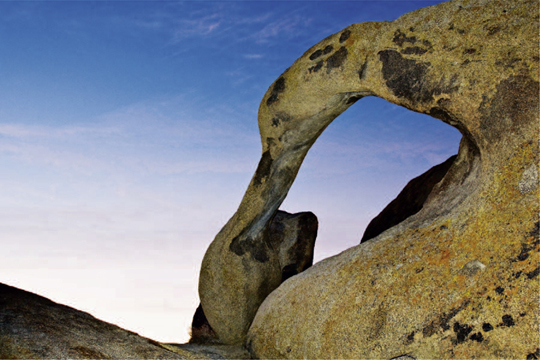
Even in Arches National Park, it’s possible to make unique images. The quality of images from high-end DSLRs is now much better than film images ever were, so you’re using the best technology that has ever existed. Remember that digital photography offers techniques that were difficult or impossible to do with film. High dynamic range (HDR) methodologies make it possible to expand the brightness range of your images more than slide film ever permitted — even with split ND filters. Shooting wonderful panoramas is easy and straightforward with digital capture. Surely you could find a veritable smorgasbord of nice panoramas in Arches National Park that have never been done before. And even if it has been done before, does it really matter? Now that electronic flash is so easy with through-the-lens metering, perhaps you can make some unique images by lighting a dark foreground with flash while allowing a long shutter speed to properly expose a brighter background such as the sky. Always remember the light — often the essence of the image — is always changing. We’re limited only by our own imagination when making unique images.
